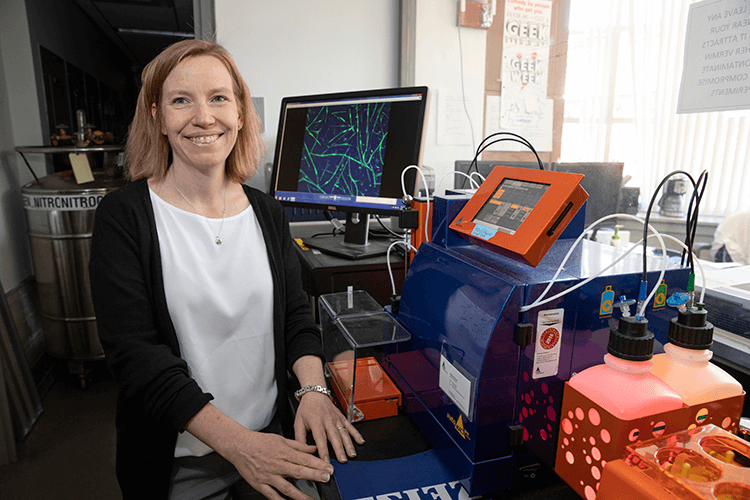News All News
January 13th, 2020
Muscular dystrophy collaboration aims to correct muscle stem cells’ DNA
Harvard stem cell research, currently in mice, receives support from Sarepta to advance in-vivo genome editing toward prospective therapy

“We expect that a satellite cell with the corrected DMD gene would quite quickly and continuously propagate the edited gene throughout the muscle tissue,” said Prof. Amy Wagers, who leads the research. (Photo credit: Jon Chase/Harvard Staff Photographer.)
Cambridge, Mass. – January 13, 2020 – Harvard University stem cell researchers led by Amy Wagers, PhD, are embarking on a major study of Duchenne muscular dystrophy (DMD). Supported by research funding from Sarepta Therapeutics, under a multi-year collaboration agreement coordinated by Harvard’s Office of Technology Development (OTD), the project aims to use in-vivo genome editing, in mouse models of DMD, to fully and precisely restore the function of the dystrophin protein, which is crucial for proper muscular growth and development. Approaches validated by this work may point the way to an eventual therapeutic strategy to reverse DMD in humans.
Duchenne muscular dystrophy is a genetic disease caused by the lack of a protein called dystrophin that normally helps to support the structural integrity of muscle fibers, including those in the heart. Without the dystrophin protein, cells are weaker and degenerate more quickly. Over time, affected individuals — boys, typically, as it is a recessive X-linked disorder — lose their capacity to move independently.
“It’s really a devastating disease; it robs young boys of their capacity to be young boys,” said Wagers, who is the Forst Family Professor of Stem Cell and Regenerative Biology, Co-Chair of the Department of Stem Cell & Regenerative Biology, and an Executive Committee Member of Harvard Stem Cell Institute. “Though it is early days, I’m hopeful that through this work we may identify and validate new avenues for therapy to completely rescue the proper expression and function of the dystrophin protein and regenerate healthy muscle tissue.”
Researchers worldwide have pursued a variety of promising approaches — such as cell and gene therapies, small-molecule therapies, and others — to lessen or prevent the disease and improve patients’ quality of life.
The strategy pursued by the Wagers Lab at Harvard aims to fully correct the genetic template for dystrophin at its source, in the DNA of stem cells (satellite cells) that create and regenerate muscle cells. Combining cutting-edge CRISPR/Cas9 genome editing technologies with a deep knowledge of stem cell science and regenerative biology, this approach if successful might offer a permanent restoration of muscular function.
“In skeletal muscle, muscle fibers are terminally post-mitotic, meaning they cannot divide and they cannot reproduce themselves,” Wagers explains. “If you lose muscle fibers, the only way to produce new muscle is from stem cells, specifically the satellite cells. The satellite cells are self-renewing, self-repairing, and ready to spring into action to create new muscle fibers. So we expect that a satellite cell with the corrected DMD gene would quite quickly and continuously propagate the edited gene throughout the muscle tissue.”
At present, research conducted in mice has shown promising results. In June, the Wagers Lab published the results of editing stem cells in vivo, demonstrating that stem cell genes can be edited in living systems, not only in a dish. In that work, Wagers and her team delivered genome editing molecules to the cells using adeno-associated viruses (AAVs). Her lab has also successfully used gene editing in heart, muscle, and satellite cells to partially restore the function of the DMD gene that encodes dystrophin, by chopping out faulty sequences of code that are disrupting the proper reading frame.
The new stem-cell approach pursued in collaboration with Sarepta would build on these achievements and use more precise genome editing approaches, in animal models of DMD, to entirely replace genetic mutations in the DMD gene with correctly encoded sequences. The project will also explore alternate delivery methods and strategies to mitigate immune effects of in vivo genome editing.
“This ambitious project will benefit greatly from the resources and insights of a company with deep clinical experience in the development of therapeutics for muscular dystrophy,” said Vivian Berlin, Managing Director of Strategic Partnerships at Harvard OTD. “Preclinical discoveries by Harvard researchers may open entirely new possibilities for lifesaving treatments in the long run, offering much-needed hope to patients and families in the future. We’re grateful to be able to sustain the important momentum already established in Prof. Wagers’ lab, through this collaboration.”
“As we work to bring forward new treatments for patients with DMD, Sarepta is excited to support Prof. Wagers and her lab to accelerate the development of a gene editing approach, which has shown significant potential in early studies,” said Louise Rodino-Klapac, Sarepta’s Senior Vice President of Gene Therapy. “This multi-year collaboration is part of Sarepta’s broader commitment to pursuing all therapeutic modalities and advancing our scientific understanding of gene editing in order to maximize the potential of this approach to help patients.”
Under the terms of the agreement between Harvard and Sarepta, the company will have the exclusive option to license any arising intellectual property for the purpose of developing products to prevent and treat human disease. As with any research agreement facilitated by OTD, the right of academic and other not-for-profit researchers to use the technology in further scholarly work is preserved.
Tags: gene editing, muscular dystrophy, stem cells
Press Contact: Kirsten Mabry | (617) 495-4157
